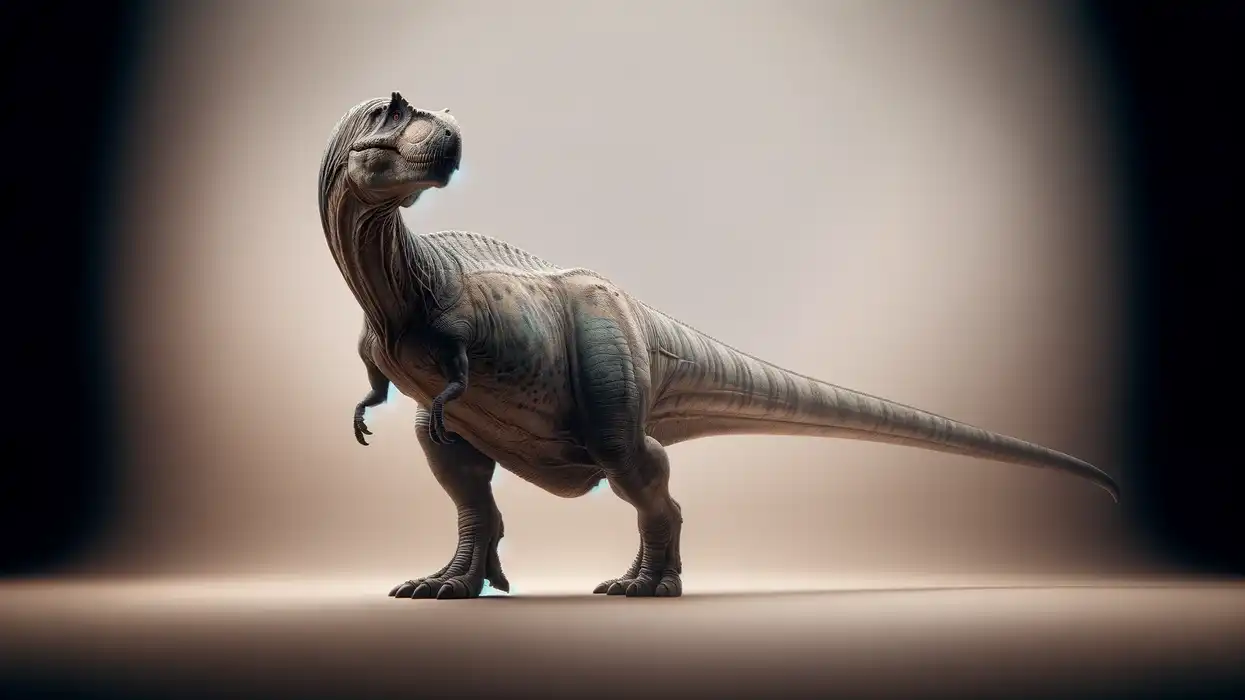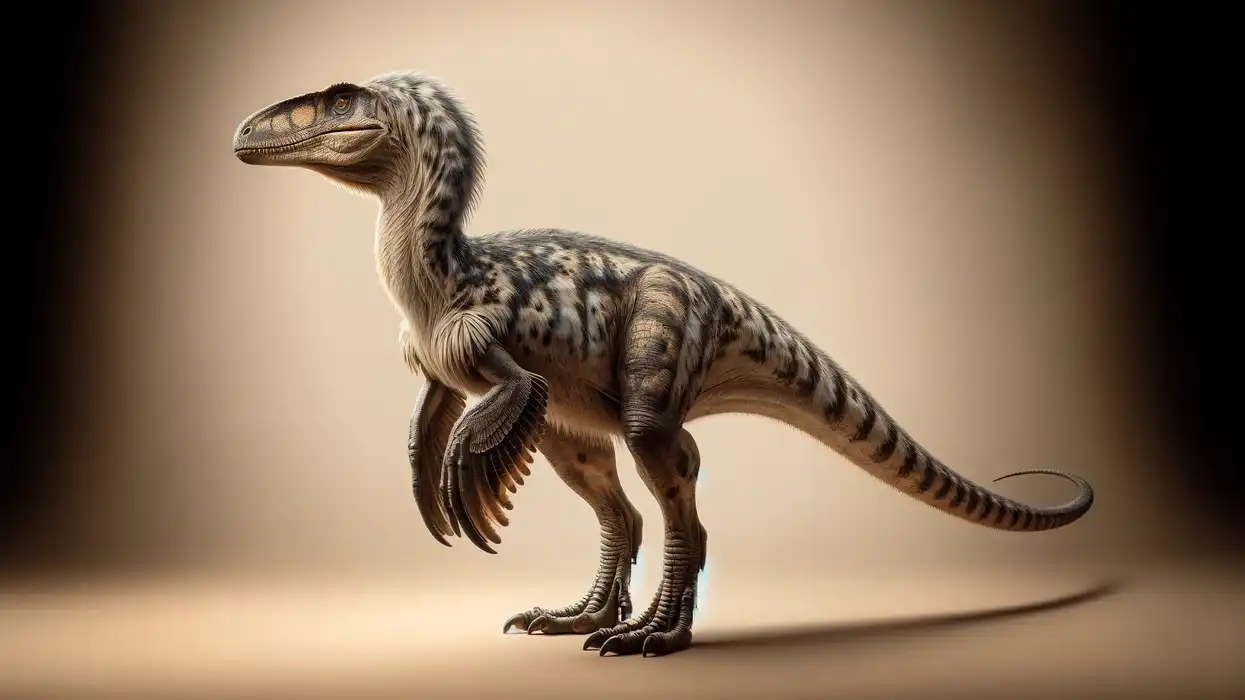Batrachognathus is an extinct pterosaur genus of the family Anurognathidae. This genus is from the Late Jurassic period in the Oxfordian-Kimmeridgian age of the Karabastau Formation in the Central Asian Republic of Kazakhstan.
Anatoly Nicolaevich Ryabinin, a Russian paleontologist, named this genus in 1948. This term is a combination of two Greek elements, batrakhoa meaning 'frog' and gnathos meaning 'jaw' referring to their wide but short head.
Batrachognathus volans is the type species within this genus. This specific term is a Latin word meaning 'flying.'
The snout to vent length of this species is 3.9 in (10 cm). The genus was assigned to this family as a relative species of Anurognathus. Species of this family have short to no tails.
Franz Nopcsa von Felsö-Szilvás named this family as the subfamily Anurognathinae in 1928 and assigned Anurognathus as a type genus. Oskar Kuhn first made use of the Anurognathidae family name.
It is often believed that these species were crepuscular or nocturnal similar to bats. Although the recurved conical teeth of these species suggest that they were primary insectivores, some of them, like the Jeholopterus, were thought to be fish-eaters or piscivores.
If you enjoyed reading these cool facts about the Batrachognathus, then make sure to check out these fun facts about the Argentavis and Ludodactylus on Kidadl.
Batrachognathus Interesting Facts
Was the Batrachognathus a dinosaur?
Batrachognathus ('frog jaw') was not a dinosaur. This genus was an extinct flying reptile species, a pterasaur.
How do you pronounce 'Batrachognathus'?
The pronunciation of Batrachognathus is 'Ba-trak-og-na-thus.'
What type of prehistoric flying bird was a Batrachognathus?
Batrachognathus ('frog jaw') was a flying reptile group in Anurognathidae within the order Pterosauria and phylum Chordata. Scientists came up with this genus based on PIN 52-2 holotype with a preserved incomplete and disarticulated skeleton with skull fragments, vertebrae, jaws, legs, wing bones, and ribs.
This Batrachognathus fossil, however, is not preserved with a tail. Batrachognathus volans is the only species within this genus.
A 2006 analysis by Lu Junchang showed that Jeholopterus and Batrachognathus are sister taxa.
This Pterosauria species was also a close relative of Anurognathus. Few adaptations of this species of Pterosauria were acrobatic and swift flights and would have caught insects in the air, and were expert aerial hunters of insects like their relative anurognathid creatures.
In which geological period did the Batrachognathus live?
This anurognathid was from the Late Jurassic period in the Oxfordian-Kimmeridgian age of the Karabastau Formation.
When did the Batrachognathus become extinct?
This pterosaur, a reptile from the Jurassic period, would have become extinct during the mass extinction event of the Cretaceous-Paleogene period around 66 million years ago.
Where did a Batrachognathus live?
This pterosaur, a reptile from the Jurassic period, lived in present-day Kazakhstan. Three fossils were recovered from the Northwest foothills of Tien Shan in the Karatau Mountains.
What was a Batrachognathus's habitat?
The Batrachognathus habitat included terrestrial areas around warm water lagoons of the Jurassic period.
Who did a Batrachognathus live with?
The information on the social life of Batrachognathus (Ryabinin, 1948) species is not clear. However, this species of the Late Jurassic might have lived in groups or on their own.
How long did a Batrachognathus live?
The information on the maximum or average lifespan of Batrachognathus of the Jurassic period is not known.
How did they reproduce?
The reproduction of Batrachognathus volans was oviparous. Information on the breeding processes, incubation, and parental care of Batrachognathus is not available.
Batrachognathus Fun Facts
What did a Batrachognathus look like?
 We've been unable to source an image of Batrachognathus and have used an image of Apatosaurus instead. If you are able to provide us with a royalty-free image of Batrachognathus, we would be happy to credit you. Please contact us at hello@kidadl.com.
We've been unable to source an image of Batrachognathus and have used an image of Apatosaurus instead. If you are able to provide us with a royalty-free image of Batrachognathus, we would be happy to credit you. Please contact us at hello@kidadl.com. Batrachognathus (Ryabinin, 1948) species of the Anurognathidae family of the Jurassic period are described from many fragmentary preserved fossil materials. The description and classification were based on PIN 52-2 holotype is an incomplete and disarticulated skeleton with skull parts, vertebrae, jaws, legs, wing bones, and ribs but not preserved with a tail.
However, it assumed that the species had a short tail. These anurognathid species have broad, short, and high skulls.
There was a total of 22-24 teeth were found in the upper jaws, along with their lower jaws the mouth was wide and short. Their broad mouth allowed them to catch insects in the air.
How many bones did a Batrachognathus have?
The information on the total number of bones in the skeleton of Batrachognathus is not available. The preserved fossil that was found consisted of skull fragments, upper and lower jaws with recurved conical teeth. The fossil remains of these pterosaurs also consisted of vertebrae, wing bones, ribs, and legs.
How did they communicate?
The information on the mode of communication of this Batrachognathus (Ryabinin, 1948) species is not known. However, like their relatives, these pterosaurs of Kazakhstan might have used body language, sight, and vocal cues to communicate.
How big was a Batrachognathus?
The Batrachognathus (Ryabinin, 1948) snout-to-vent length was 3.9 in (10 cm) long. The skull length of these anurognathids was 1.9 in (48 mm) long.
Batrachognathus' wingspan was 20 in (50 cm) in length. However, in 2000, David Unwin estimated the wingspan to be around 30 in (75 cm). The wingspan of the related Luopterus species was half the size at around 16 in (40 cm).
How fast could a Batrachognathus fly?
The information on the flying speed of these anurognathids is not available.
How much did a Batrachognathus weigh?
The weight of this animal is unknown.
What were the male and female names of the species?
There was no specific name given to either female or male of these anurognathids of the Jurassic period.
What would you call a baby Batrachognathus?
There was no specific name given to these baby anurognathids.
What did they eat?
Their diet was insectivorous. The lake area where the fossils of these anurognathids were found was a perfect breeding place for insects that were preferred by these pterosaurs. This is proved by the recurved conical teeth in their large mouth. They might have fed on swifts, bats, swallows, and nightjars, if they were around today.
How aggressive were they?
Information on the aggressiveness of Batrachognathus is not known.
Did you know...
The relatives of Batrachognathus, Anurogathus classification is within the family anurognathidae and subfamily anurognathinae. The name is a combination of Greek terms, an means 'without,' oura means 'tail,' and gnathos means 'jaw.'
How did Batrachognathus protect itself?
It is not exactly known how these species might have protected themselves. However, like bats, these species might have stayed in groups to stay away from predators like larger flying dinosaurs of that period.
Where are Batrachognathus fossils commonly found?
The fossils of Batrachognathus volans were commonly recovered from the Karabastau Formation of Kazakhstan and foothills of the Karatau Mountains.
Here at Kidadl, we have carefully created lots of interesting family-friendly prehistoric animal facts for everyone to discover! For more relatable content, check out these Scaphognathus facts and Machimosauruses facts for kids.
You can even occupy yourself at home by coloring in one of our free printable Batrachognathus coloring pages.
*We've been unable to source an image of Batrachognathus and have used an image of Pterodactyloidea instead. If you are able to provide us with a royalty-free image of Batrachognathus, we would be happy to credit you. Please contact us at hello@kidadl.com.









